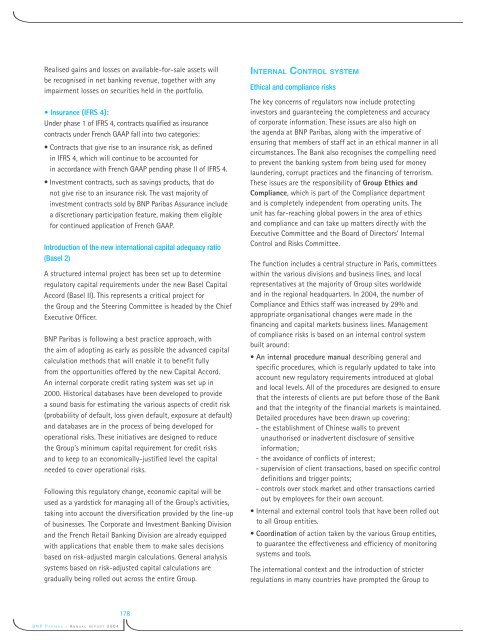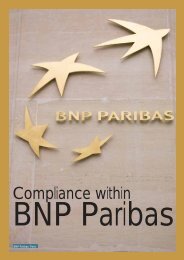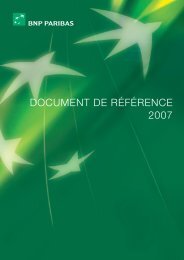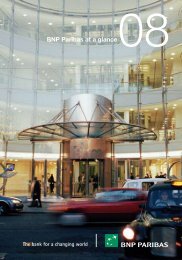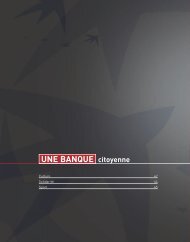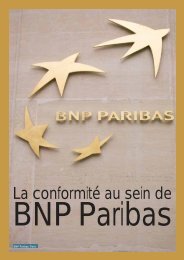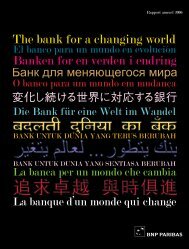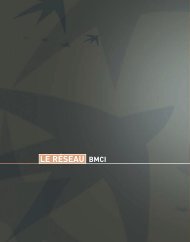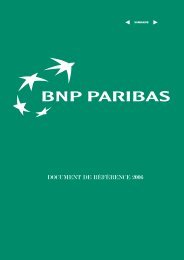La banque d'un monde qui change 2004 - BNP Paribas
La banque d'un monde qui change 2004 - BNP Paribas
La banque d'un monde qui change 2004 - BNP Paribas
Create successful ePaper yourself
Turn your PDF publications into a flip-book with our unique Google optimized e-Paper software.
Realised gains and losses on available-for-sale assets willbe recognised in net banking revenue, together with anyimpairment losses on securities held in the portfolio.• Insurance (IFRS 4):Under phase 1 of IFRS 4, contracts qualified as insurancecontracts under French GAAP fall into two categories:• Contracts that give rise to an insurance risk, as definedin IFRS 4, which will continue to be accounted forin accordance with French GAAP pending phase II of IFRS 4.• Investment contracts, such as savings products, that donot give rise to an insurance risk. The vast majority ofinvestment contracts sold by <strong>BNP</strong> <strong>Paribas</strong> Assurance includea discretionary participation feature, making them eligiblefor continued application of French GAAP.Introduction of the new international capital adequacy ratio(Basel 2)A structured internal project has been set up to determineregulatory capital re<strong>qui</strong>rements under the new Basel CapitalAccord (Basel II). This represents a critical project forthe Group and the Steering Committee is headed by the ChiefExecutive Officer.<strong>BNP</strong> <strong>Paribas</strong> is following a best practice approach, withthe aim of adopting as early as possible the advanced capitalcalculation methods that will enable it to benefit fullyfrom the opportunities offered by the new Capital Accord.An internal corporate credit rating system was set up in2000. Historical databases have been developed to providea sound basis for estimating the various aspects of credit risk(probability of default, loss given default, exposure at default)and databases are in the process of being developed foroperational risks. These initiatives are designed to reducethe Group’s minimum capital re<strong>qui</strong>rement for credit risksand to keep to an economically-justified level the capitalneeded to cover operational risks.Following this regulatory <strong>change</strong>, economic capital will beused as a yardstick for managing all of the Group’s activities,taking into account the diversification provided by the line-upof businesses. The Corporate and Investment Banking Divisionand the French Retail Banking Division are already e<strong>qui</strong>ppedwith applications that enable them to make sales decisionsbased on risk-adjusted margin calculations. General analysissystems based on risk-adjusted capital calculations aregradually being rolled out across the entire Group.INTERNAL CONTROL SYSTEMEthical and compliance risksThe key concerns of regulators now include protectinginvestors and guaranteeing the completeness and accuracyof corporate information. These issues are also high onthe agenda at <strong>BNP</strong> <strong>Paribas</strong>, along with the imperative ofensuring that members of staff act in an ethical manner in allcircumstances. The Bank also recognises the compelling needto prevent the banking system from being used for moneylaundering, corrupt practices and the financing of terrorism.These issues are the responsibility of Group Ethics andCompliance, which is part of the Compliance departmentand is completely independent from operating units. Theunit has far-reaching global powers in the area of ethicsand compliance and can take up matters directly with theExecutive Committee and the Board of Directors’ InternalControl and Risks Committee.The function includes a central structure in Paris, committeeswithin the various divisions and business lines, and localrepresentatives at the majority of Group sites worldwideand in the regional headquarters. In <strong>2004</strong>, the number ofCompliance and Ethics staff was increased by 29% andappropriate organisational <strong>change</strong>s were made in thefinancing and capital markets business lines. Managementof compliance risks is based on an internal control systembuilt around:• An internal procedure manual describing general andspecific procedures, which is regularly updated to take intoaccount new regulatory re<strong>qui</strong>rements introduced at globaland local levels. All of the procedures are designed to ensurethat the interests of clients are put before those of the Bankand that the integrity of the financial markets is maintained.Detailed procedures have been drawn up covering:- the establishment of Chinese walls to preventunauthorised or inadvertent disclosure of sensitiveinformation;- the avoidance of conflicts of interest;- supervision of client transactions, based on specific controldefinitions and trigger points;- controls over stock market and other transactions carriedout by employees for their own account.• Internal and external control tools that have been rolled outto all Group entities.• Coordination of action taken by the various Group entities,to guarantee the effectiveness and efficiency of monitoringsystems and tools.The international context and the introduction of stricterregulations in many countries have prompted the Group to178<strong>BNP</strong> PARIBAS - ANNUAL REPORT <strong>2004</strong>


